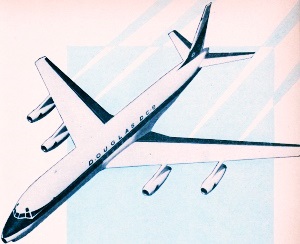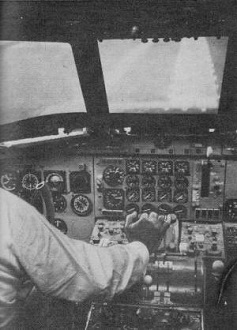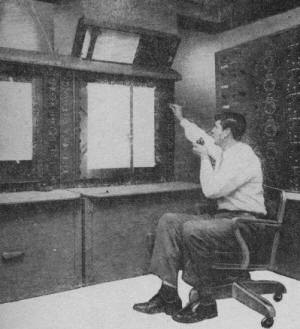|
December 1958 Popular Electronics
 Table
of Contents Table
of Contents
Wax nostalgic about and learn from the history of early electronics. See articles
from
Popular Electronics,
published October 1954 - April 1985. All copyrights are hereby acknowledged.
|
My flight simulator
software (MS Flight Sim 2002) and computer it runs on (HP i7 notebook) are each
more powerful than the software and computer that ran the Douglas DC-8 pilot training
simulator featured in this 1958 article in Popular Electronics magazine.
Two racks of 1000+ vacuum tubes did the figurative electronic heavy lifting
while massive DC motors did the literal physical cockpit heavy lifting. The computer
needed to handle as many as 40 variables at one time, including 6 differential equations
of motion. 100 servomotors, 540 amplifiers and 2,200 gears drove the instrument
panel gauges, dials, and movie projector mechanisms. The instrument panel description
conjures images of the inside of a modern office-grade copying machine with its
very dense conglomeration of gears and axels (have you seen the inside of one of
those lately?).
Flying High at Zero Altitude
 By Ben Preece By Ben Preece
The pilot and co-pilot of the Douglas DC-8 Jetliner couldn't see anything through
the windshield. It was totally dark outside. The altimeter was winding down as the
giant plane dropped through the overcast. The crew chief watched his instrument
panel.
"We'll be out in a minute," the pilot said, referring to the cloud bank he'd
been in since take-off. Then the lights of the field appeared below.
"There it is," the copilot gestured. A bright, double row of lights, outlining
the runway, could be seen ahead and below. The DC-8 Jetliner dropped slowly until
it was over the runway. The pilot pulled the nose up, there was a slight bump, then
a squeal of tires as the brakes were applied, and the ship had landed.
The pilot, copilot and crew chief had just experienced a coast-to-coast flight.
However, their greatest altitude had been under ten feet, the greatest speed zero
miles an hour. Yet, except for the gravitational forces, this crew had experienced
every sensation of being in an airplane flying five hundred miles per hour at 35,000
feet. They had just completed a "ride" in the DC-8 flight simulator!
Electronic Flight

An artist's concept of the DC-8 Jetliner simulator setup. As
the pilot "flies" the simulator, a television camera traces the plane's path along
a three-dimensional model of an airport and approach area on the rear wall. The
TV picture is projected on the screen in front of the cockpit. At the side of the
room are racks which house the electronic "brain" of the simulator.

Pilots learn to fly the Douglas DC-8 Jetliner on terra firma.
Here, a pilot "checks out" for the first time. The cockpit exactly duplicates the
DC-8 controls. Closed-circuit TV projector provides realistic visual impression
encountered during landings and take-offs. The simulator was produced by Link Aviation,
Inc.

The simulated DC-8 Jetliner's flight is traced on these maps
in the control room of the simulator. The instructor makes the necessary control
tower and check-point voice communications. Controls at the extreme right provide
radio and navigation signals.

"Brain" of the simulator. Two rows of electronic devices comprise
the analog computers and servomechanisms. In addition to literally thousands of
electron tubes and resistors, the "brain" contains 100 servo motor-generator sets,
540 amplifiers and 2200 gears.
The DC-8 simulator works electronically to produce all the sensations of flying,
including correct instrument readings, climb and bank altitudes, everything. It
even has a closed-circuit television system which shows you an airfield, just as
you would see it in the real DC-8.
Such simulators train pilots to fly planes that haven't rolled off the assembly
line.
Swift, new planes like the Douglas DC-8, the Boeing 707 and the Lockheed Electra
will be "old hat" to airline pilots when they go into service.
A DC-8 simulator is as realistic as the actual airplane. It consists of a cockpit
section, a scale model airport, a closed-circuit television system, and a computer
system and servomechanisms to control the position of the cockpit section.
Realism in Training
The cockpit has all the dials, levers and gauges of the DC-8 itself. When the
pilot "flies" the simulator, he experiences all the motions he would feel in real
flight, except the g-loads. There are air pockets, sudden wind gusts, the sound
of the jet engines, even the two quick jars the real DC-8 feels when it slips into
a bank at high altitude and the wings lose their lift.
The crew of the simulator consists of the pilot, copilot, crew chief and instructor.
Additional personnel outside operate the radio signal system and the closed-circuit
television. The instructor can simulate any emergency a pilot will find in flight.
The crew in the radio control room can duplicate the signal of any radio station
in the world, and send six signals at once. Thus, the pilot may receive every radio
indication that he is flying over Chicago, New York, Los Angeles or London. The
radio crew can even vary the compass reading to allow for the magnetic variation
typical in any part of the world.
In short, once the pilot and his crew take their seats, they are in a real airplane.
When the jet engines are running, the cockpit may buck against the brakes, depending
upon the throttle setting. When the brakes are released...off they go! The runway
lights whirl by on either side. Looking straight ahead, the crew has the illusion
of motion as the lights go by.
In the air, the instructor throws the book at the pilot. Engine failure may "occur,"
hydraulic failure, cooling system failure, a change in the plane's center of gravity,
or any other trouble. More than one pilot has been saved by his simulator training.
It teaches him to think fast and to do the right thing in a split second.
The DC-8 simulator does everything but fly. "It's really an electronic brain,"
one engineer said. "It must handle as many as forty variables at one time, including
the six differential equations of motion. Then it must solve the problem and translate
the answer into airplane motion, instrument readings and a visual television picture
for the pilot."
Among those forty variables are engine thrust, fuel pressure, Mach number, altitude,
rate of climb or descent, and many others.
Simulator Design
D.C. circuits are used throughout for several reasons. Direct current provides
a higher degree of accuracy, eliminates the possibility of phase shift, harmonic
distortion, erratic instrument motion and noise pickup. The circuits are simpler
and therefore easier to maintain. Direct current also eliminates the fluctuations
and variations inherent in most of the alternating current supplies.
The DC-8 simulator uses printed-circuit boards and utilizes various electronic
systems. For example: the characteristics of the engines are carried electronically
on one circuit board. If another engine with an extra 500 horsepower is to be inserted,
the old engine circuit board is removed and the new one plugged in. This way "engines"
can be switched in only half an hour.
A room behind the cockpit section is lined with tall, grey cabinets. On the left
are racks holding various amplifiers and other electronic gear. On the right are
small circuit boards and motors with spinning dials. Under each unit is a label:
Fuel Flow, Bank, Altitude, etc. The computer essentially takes a rate of change,
integrates it, and tells the crew through cockpit motion or instrument readings
just what is happening.
Televised Airport

A television camera scans a miniature relief map built to a
300:1 scale. The camera is automatically positioned along the aircraft course
and altitude, and assumes the aircraft attitude. Movement of camera is governed
by electronic response of simulated Jetliner to pilot's controls. The relief map
is wall-mounted to save floor space.
In the TV room there is a model airport made to scale mounted on a long wall.
A television camera is mounted on two tracks which run the length of the model airport.
The model is built to a three-hundred- to-one scale, and represents an area 21,000
feet by 3000 feet. The TV camera is connected to the computer system. If the pilot
dives, the camera tilts down. If he climbs, the camera tilts up. It follows every
motion of the airplane, so it sees what the pilot would see. The picture is then
flashed on the screen in front of the pilot.
A television projector is located on top of the DC-8 simulator cockpit. And the
televised picture from the map room is projected onto a motion picture screen which
covers the visible area viewed by the pilots in training.
The DC-8 simulator gives to the public a well-trained, proficient crew. This
flying team practices and "polishes" on the ground. When the Jetliners are put into
operation, the passengers can be sure that the pilot and his crew have many hours
of simulated and actual flying time under their belts. The simulator offers safety
through practice.
Posted September 16, 2022
(updated from original
post on 1/1/2013)
|



























 By Ben Preece
By Ben Preece




